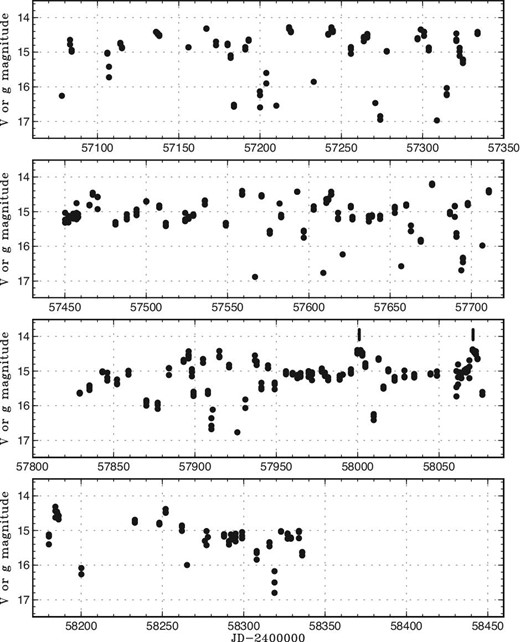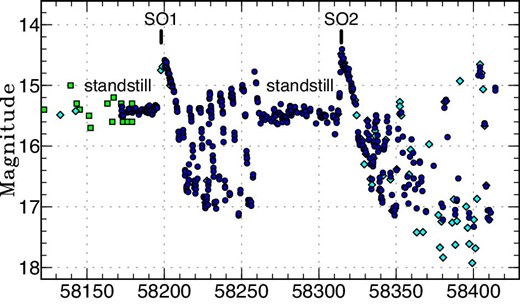-
PDF
- Split View
-
Views
-
Cite
Cite
Taichi Kato, Three Z Camelopardalis-type dwarf novae exhibiting IW Andromedae-type phenomenon, Publications of the Astronomical Society of Japan, Volume 71, Issue 1, January 2019, 20, https://doi.org/10.1093/pasj/psy138
Close - Share Icon Share
Abstract
I found that V507 Cyg, IM Eri, and FY Vul are Z Cam-type dwarf novae and they showed sequences of standstill terminated by brightening, in contrast to fading as ordinary Z Cam stars do, followed by damping oscillation. These sequences are characteristic to IW And-type objects (also known as anomalous Z Cam stars). New additions to the IW And-type objects suggest that the IW And-type phenomenon is more prevalent among Z Cam stars. I suspect that the regularity of the pattern of the IW And-type phenomenon suggests a previously unknown type of limit-cycle oscillation, and I suggest that the standstill in these objects is somehow maintained in the inner part of the disk and that the thermal instability starting from the outer part of the disk terminates the standstill to complete the cycle.
1 Introduction
Dwarf novae are a class of cataclysmic variables, which are close binary systems composed of a white dwarf and a red-dwarf-secondary transferring matter via the Roche-lobe overflow. In dwarf novae, thermal instability in the disk is believed to cause repetitive outbursts [see, e.g., Osaki (1996); for general information of cataclysmic variables and dwarf novae, see, e.g., Warner (1995)].
When the mass-transfer from the secondary is high, the disk can become thermally stable (when the disk is always thermally stable, such systems are called nova-like cataclysmic variables). Z Cam stars are systems which transiently show a thermally stable disk. Standstills in Z Cam stars are intermediate states between outburst maxima and minima, and Z Cam stars spend states with ordinary dwarf nova outbursts and standstills intermittently. Z Cam stars are considered to have relatively high mass-transfer rates and the accretion disk is considered to be close to the thermal stability. It is generally considered that a subtle variation in the mass-transfer rate from the secondary causes transitions between outbursting state and standstills (Meyer & Meyer-Hofmeister 1983) [see also a review of dwarf nova outbursts, e.g., Osaki (1996)].
There has been at least one attempt to explain standstills without introducing the mass-transfer variation (Ross & Latter 2017). This attempt has not yet been successful in reproducing the actual Z Cam-type behavior.
On the other hand, unusual Z Cam stars were identified by the “Z CamPaign” led by Simonsen (2011). They were IW And and V513 Cas, which occasionally showed a very regular sequence of standstill–brightening–damping oscillation [figure 1 for IW And; figures 1 and 2 in Simonsen (2011); also in Szkody et al. (2013)]. The most interesting features are that (1) standstills are terminated by brightening, not by fading as in “textbook” Z Cam stars, and (2) the sequence is often very regular with almost a constant recurrence time (∼40 d in IW And in 2009–2010 and 40–50 d in V513 Cas in 2010). Although these objects are sometimes referred to as “anomalous Z Cam stars” (cf. Hameury & Lasota 2014), I propose a more specific name of “IW And-type objects (or phenomenon)” after the brightest and easily pronounceable prototype star.1

Light curve of IW And using the ASAS-SN data. The “V” marks represent upper limits. The vertical ticks represents brightening terminating standstills.

Light curve of V507 Cyg using the ASAS-SN data. Two cycles of standstill–brightening–damping oscillation (IW And-type phenomenon) can be seen between JD 2457950 and JD 2457080. The vertical marks represents brightening terminating standstills.
Another dwarf nova, ST Cha, was found to belong to IW And-type objects (Simonsen et al. 2014). Although its similarity with IW And-type objects was not documented, the Kepler dwarf nova KIC 9406652 showed a similar pattern of outbursts (but with smaller amplitudes) (Gies et al. 2013).
During the course of a systematic study of cataclysmic variables using Gaia DR2 (Gaia Collaboration 2018), I noticed that variable stars V507 Cyg, IM Eri, and FY Vul belong to IW And-type stars.
2 Observations
I used the All-Sky Automated Survey for Supernovae (ASAS-SN) Sky Patrol (Shappee et al. 2014; Kochanek et al. 2017). These observations were made by using 14-cm aperture telephoto lenses and CCD cameras equipped with V or g filters [see Kochanek et al. (2017) for more technical details]. Observations were usually made two or three times in one night and they were repeated at intervals of 1–5 d (the intervals were sometimes longer due to unfavorable conditions). Since V and g magnitudes are almost the same in dwarf novae, I used them without corrections to draw light curves.
3 Results
The resultant light curve is shown in figure 2. Although the object spent much of the time showing typical Z Cam-type behavior with occasional standstills (first and second panels), the object showed the IW And-type phenomenon (standstill–brightening–damping oscillation) between JD 2457950 and JD 2457080, seen in the third panel. IM Eri showed the same phenomenon (figure 3). The light curve of FY Vul is shown in figure 4.

Light curve of IM Eri using the ASAS-SN data. Cycles of standstill–brightening–damping oscillation (IW And-type phenomenon) can be seen throughout these observations. The vertical marks represent brightening terminating standstills. A dip after the third brightening (JD 2457730) was probably missed due to the gap in the observation.

Light curve of FY Vul using the ASAS-SN data. Somewhat less regular cycles of standstill–brightening–damping oscillation (IW And-type phenomenon) can be seen, particularly in the upper panel. The vertical marks represent brightening terminating standstills. The final two standstills were associated by brightening, but not followed by dips.
For comparison, I provide the light curve of ST Cha on the same scale in figure 5 since the regular nature of the IW And-type phenomenon was less clear in Simonsen et al. (2014).

Light curve of ST Cha using the ASAS-SN data. The IW And-type phenomenon was most prominent in this segment. The vertical ticks represent brightening terminating standstills.
4 Discussion
With a new addition of members to the IW And-type objects (and clear representation of the case of ST Cha in this paper), it has become more evident that the IW And-type phenomenon is more prevalent among Z Cam stars than previously thought.
Hameury and Lasota (2014) suggested that termination of standstills in the IW And-type phenomenon (standstills terminate by brightening) can be explained by outbursts of mass transfer with a duration of a few days. The actual light curves of IW And-type objects, however, are very regular (as seen in figure 5 and figures in Simonsen 2011), and it would be difficult to suppose such a regular occurrence of “giant flares” occurring near the secondary star surface (Hameury & Lasota 2014). The regularity, on the other hand, would suggest a previously unknown limit-cycle oscillation in the accretion disk [logically analogous to the one proposed for the black-hole transient V404 Cyg in Kimura et al. (2016)].
Quite recently, I found that the SU UMa-type dwarf nova NY Ser showed standstills and that superoutbursts started from these standstills (figure 6; vsnet-alert 22026, 22313; Kato et al. 2018).2 These standstills and superoutbursts were phenomenologically very similar (standstills were terminated by brightening). The development of superoutbursts during standstills provides strong evidence that the disk radius reached the 3:1 resonance during standstills in NY Ser. This implies that the disk radius increased during these standstills and eventually triggered the tidal instability at the 3:1 resonance. This phenomenon in NY Ser suggests that the disk radius can increase during standstills, possibly caused by re-distribution of the surface density in the disk during standstills. I consider that a similar situation could happen in IW And-type objects: the standstill is initially maintained in the inner part of the disk, the disk gradually expands, and the thermal instability starting from the outer part of the disk sweeps the entire disk down to the quiescent state.

Light curve of NY Ser in 2018 reproduced from figure 1 in Kato et al. (2018). The abscissa is in BJD−2400000. This SU UMa-type dwarf nova showed standstills which were terminated by superoutbursts (SO1 and SO2). (Color online)
The referee of this paper suggested a possibility that a decreasing mass-transfer rate can lead to a disk radius increase when the disk is in a high state (as it is during a standstill). I consider, however, this interpretation less likely for several reasons. (1) Although the disk can expand in response to the decrease in the mass-transfer rate, the surface density should decrease and the thermal instability will become more difficult to start from the outer disk. (2) Several IW And-type stars show regular cycles characterized by recurrence times of tens of days. This should require a regular decrease in the mass-transfer rate, which has not been observed in other systems and would be difficult to produce. (3) The brightness during standstills increases in some systems (most clearly seen in FY Vul and ST Cha), which contradicts the idea of a decrease in the mass-transfer rate.
For these reasons, I prefer the original working hypothesis that the thermal instability starting from the outer part of the disk sweeps the entire disk even with constant mass-transfer from the secondary by a yet unidentified mechanism. In FY Vul, brightening from standstills did not result in the subsequent quiescent state (figure 4). I consider that the cooling wave was not strong enough to sweeps the entire disk, and that the system returned to the original standstill state. It may be that the disk in standstill may be related to the intermediate state in the “S-curve” of the thermal equilibrium curve [Meyer-Hofmeister (1987); figure 9 in Osaki and Kato (2014), figure 6 in Meyer and Meyer-Hofmeister (2015)]. Further theoretical study is needed to explain how the standstill can be maintained in the inner part of the disk and why the IW And-type phenomenon is only seen in some Z Cam stars.
Acknowledgements
The author is particularly grateful to the ASAS-SN team for making their data available to the public. A discussion with Y. Osaki about the IW And-type phenomenon was very illuminating. I acknowledge the referee Dr. Mattias Schreiber for his constructive comments. This research has made use of the SIMBAD database, operated at CDS, Strasbourg, France. This research has made use of the International Variable Star Index (VSX) database, operated at AAVSO, Cambridge, Massachusetts, USA. This work has made use of data from the European Space Agency (ESA) mission Gaia (https://www.cosmos.esa.int/gaia), processed by the Gaia Data Processing and Analysis Consortium (DPAC, https://www.cosmos.esa.int/web/gaia/dpac/consortium). Funding for the DPAC has been provided by national institutions, in particular the institutions participating in the Gaia Multilateral Agreement.The author is grateful to H. Maehara for making Gaia DR2 data available to the author enabling a systematic study of cataclysmic variables.
Footnotes
The Z Cam-type nature of IW And was first recognized by Kato, Ishioka, and Uemura (2003), who incidentally recorded an entrance to a standstill following outbursts. A rise from the standstill in the final part of the observation suggests that the anomalous ending of the standstill was already present in 2002.
The vsnet-alert messages can be seen at 〈http://ooruri.kusastro.kyoto-u.ac.jp/pipermail/vsnet-alert/〉.
References



